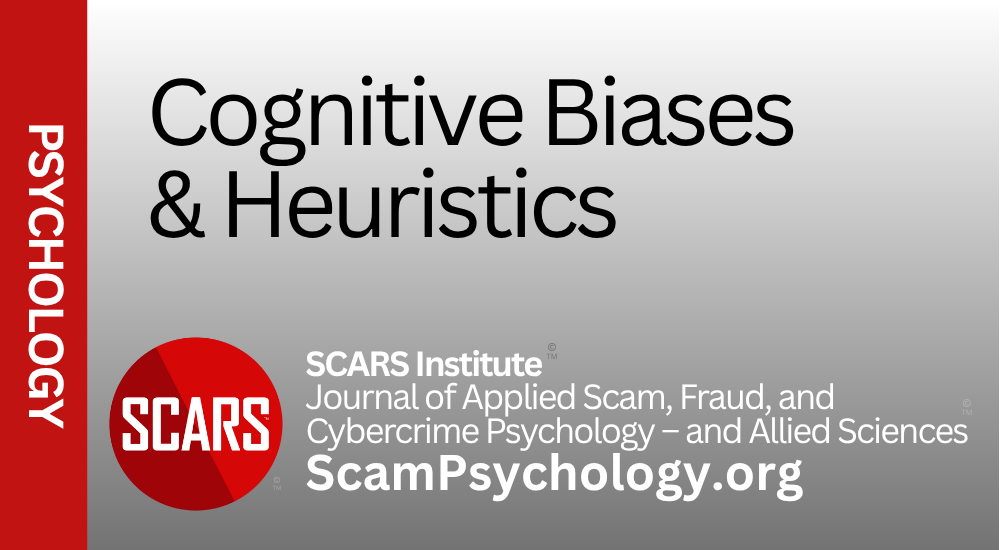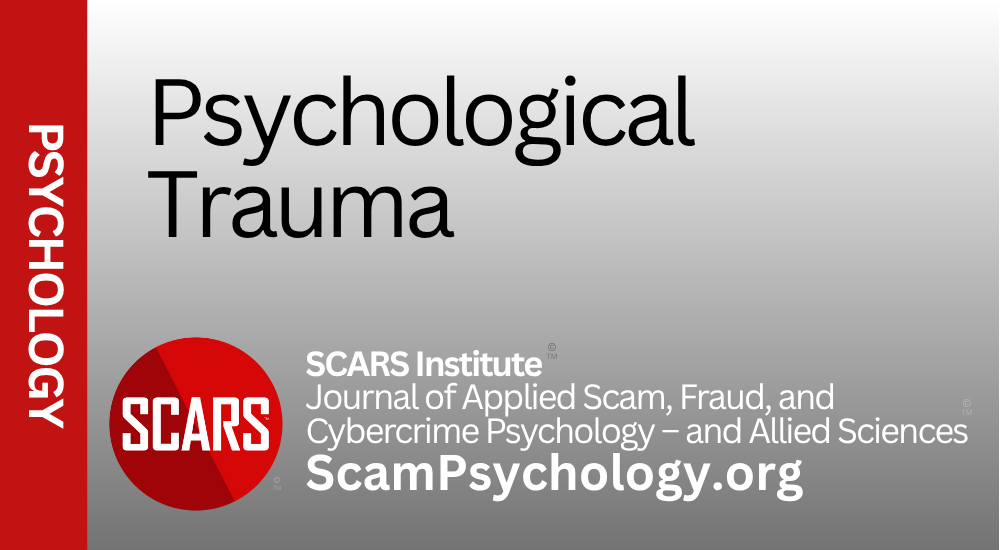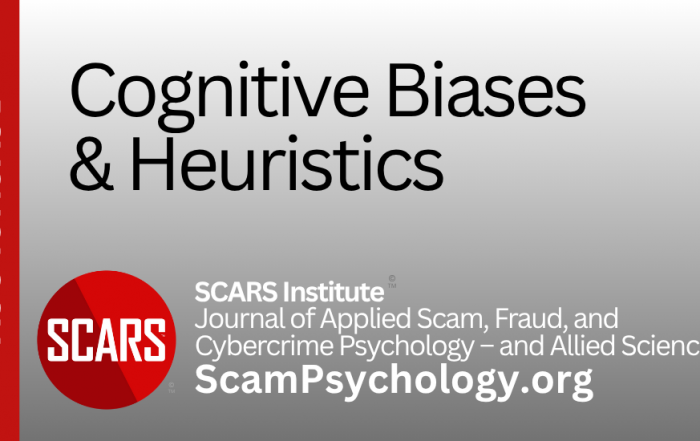
The Freeze Response: What Happens in the Mind and Body
Principal Category: Psychological Trauma Responses
Authors:
• Vianey Gonzalez B.Sc(Psych) – Licensed Psychologist, Specialty in Crime Victim Trauma Therapy, Neuropsychologist, Certified Deception Professional, Psychology Advisory Panel & Director of the Society of Citizens Against Relationship Scams Inc.
• Tim McGuinness, Ph.D. – Anthropologist, Scientist, Polymath, Director of the Society of Citizens Against Relationship Scams Inc.
Abstract
The freeze response is a natural survival mechanism that activates when the brain perceives overwhelming danger. Unlike fight or flight, freeze involves physical and psychological shutdown. The body slows movement, lowers heart rate, and restricts breathing through activation of the dorsal vagal system. Cognitively, the prefrontal cortex reduces activity, leading to mental fog, dissociation, and helplessness. This response protects the system from further harm, but can create long-term problems if it becomes chronic. Trauma survivors often remain stuck in a state of functional freeze, experiencing numbness, fatigue, and social withdrawal. Physical symptoms may include muscle tension, pain, and digestive issues. Recovery involves body-based therapies, breathwork, and trauma-informed movement to help the nervous system reset. Understanding the freeze response removes shame and provides survivors with practical tools for healing. This article explains the freeze response in detail and offers guidance for moving from shutdown back to life engagement.

The Freeze Response: What Happens in the Mind and Body
Author’s Note
This content is intended as an introductory explanation of the freeze response in trauma, particularly for scam victims, betrayal trauma survivors, and anyone who has experienced overwhelming emotional or psychological threat. It provides an overview of the neurological, psychological, and somatic mechanisms that drive the freeze reaction. The focus is on helping readers understand why the body and mind shut down during crisis and why this state sometimes persists long after the danger has passed.
Nothing in this article should be interpreted as a diagnostic tool or treatment plan. Each person’s experience with trauma and nervous system responses is unique and shaped by many factors. The information presented here is based on current research and recognized models of trauma response, but it cannot address every individual’s circumstances or health needs. Recovery from chronic freeze often requires personalized support from trauma-certified professionals who understand both psychological and somatic healing.
Readers who see themselves in these descriptions are encouraged to consult with licensed mental health providers or somatic therapists trained in trauma recovery. This work is designed to raise awareness and foster understanding of the freeze response. It is not a substitute for professional care. Use this information as a foundation for learning and healing, not as a final answer.
1: Overview
The freeze response is part of the defense cascade, which is your body’s automatic survival system. This system includes fight, flight, freeze, submit, and collapse. These are not choices you make consciously. They are hardwired responses that your nervous system activates when you perceive danger.
When you experience a threat that feels inescapable or overwhelming, your body may shift into freeze. This can happen during a traumatic event, especially when:
- Escape is impossible.
- Fighting back seems futile.
- Social or emotional threats feel life-altering.
- There is sudden shock, confusion, or emotional betrayal.
In these situations, the freeze response becomes a trauma response because the brain shifts from active survival strategies (fight or flight) to passive survival strategies (freeze or submit). Your system essentially decides, “I cannot win this. I cannot get away. My best chance is to shut down.”
Why Freeze Is Linked to Trauma
After the crisis ends, your nervous system does not always reset properly. Many trauma survivors stay stuck in freeze because the event was never fully processed or resolved. The trauma locks the system into a loop of:
- Numbness
- Emotional shutdown
- Physical stillness or tension
- Avoidance of action or decision-making
This is why the freeze response is often associated with post-traumatic stress, betrayal trauma, and chronic anxiety. The system learned to survive by freezing, but it did not learn how to unfreeze afterward.
Key Difference: Acute Freeze vs Trauma Freeze
- Acute freeze happens in the moment of danger. It is a natural and sometimes lifesaving response.
- Trauma-related freeze happens when that acute state does not resolve. The body stays stuck in shutdown mode long after the threat is gone.
Clinical Perspectives
Dr. Stephen Porges’ Polyvagal Theory explains this in terms of nervous system hierarchy. When social engagement and fight or flight fail, the dorsal vagal complex takes over. This creates physical and emotional shutdown.
Dr. Peter Levine, in Waking the Tiger, describes trauma as the incomplete discharge of survival energy. Freeze happens when you cannot complete the defensive act, whether that is running away, fighting back, or speaking up. The body holds onto that energy, and the freeze state becomes chronic.
The freeze response is both a natural survival response and a trauma response when it becomes stuck. Understanding this difference is critical for healing, especially for scam victims, betrayal trauma survivors, and anyone recovering from emotional or physical threats.
2: Introduction to the Freeze Response in Crisis
The freeze response is one of the least understood survival reactions. Most people are familiar with fight or flight, but they rarely understand freeze. Yet freeze is just as important, and often just as common. When an individual cannot safely fight back or run away, the system defaults to freezing. This is not a conscious decision. It is an automatic survival mechanism that activates in the brain, the nervous system, and the body all at once.
Freezing is not about weakness. It is about protection. The nervous system makes a split-second calculation. If escape is impossible and fighting would lead to worse harm, it shifts into stillness. The body and mind go into shutdown mode to reduce pain, limit visibility to predators, or help the individual survive trauma. This pattern is seen in animals, and it exists in humans as well. It is part of evolutionary biology.
For scam victims, betrayal trauma survivors, and people facing emotional overwhelm, the freeze response is common. It explains why some people do not fight back when manipulated. It explains why others feel paralyzed when confronted with emotional harm or financial scams. The same biological systems that react to physical danger also respond to emotional threat. The brain does not always distinguish between a physical attacker and a psychological one. Both can trigger freeze.
The Neurological Mechanics of Freeze
The freeze response begins in the brain. The first part of the brain to react to danger is the amygdala. This structure functions as the brain’s early warning system. It scans for threats and sends signals faster than the conscious mind can process. When the amygdala detects danger, it alerts the hypothalamus and the brainstem to activate a survival response.
If fighting or fleeing seems impossible, the brain switches to freezing. This happens in the periaqueductal gray (PAG), a structure in the midbrain. The PAG decides between fight, flight, or freeze based on the situation. When it chooses freeze, it activates pathways that slow down the body, reduce movement, and shift the system into stillness. This is sometimes called tonic immobility. It is well-documented in animals but also occurs in humans under extreme stress.
The vagus nerve plays a key role in this process. According to Polyvagal Theory, the vagus nerve has two branches. The ventral vagal branch supports calmness and social connection. The dorsal vagal branch supports shutdown. When the dorsal vagus takes over, the heart rate slows, breathing becomes shallow, and the body begins conserving energy. This is the biological root of the freeze response.
Research shows that the brain reduces activity in the prefrontal cortex during freeze. The prefrontal cortex manages decision-making and logic. When the survival system takes control, rational thought becomes suppressed. The body moves into autopilot to survive the immediate threat.
The Psychological Effects of Freeze
Freezing does not happen only in the body. It happens in the mind as well. During a freeze response, individuals may experience mental shutdown. This feels like numbness, dissociation, or emotional disconnection. Some people describe it as watching things happen from outside the body. Others report that their mind goes blank. They cannot think, speak, or respond the way they would normally.
This happens because the brain cuts off access to normal problem-solving. In a survival situation, reflection and conversation are not priorities. The system focuses on getting through the moment with as little damage as possible. Freezing helps reduce sensory overload by narrowing mental focus.
The emotional effect of freeze is often helplessness. People often report knowing that something bad is happening but feeling powerless to stop it. This is common in trauma and scam situations. Victims often say, “I wanted to act, but I could not move or speak.” This is not a personal failure. It is a biological response designed to help the system survive danger that feels inescapable.
The Somatic Experience of Freeze
The body responds to freeze in specific ways. Breathing becomes shallow or pauses. Heart rate slows down. This is called bradycardia. Muscles may stiffen or become limp. Some people report cold hands, dizziness, or a sensation of fading out. In extreme cases, people faint.
These reactions are not random. They are part of an ancient survival system. Animals in the wild use freeze to avoid predators. Humans inherited the same pattern. The body becomes still, attempting to become less noticeable or to reduce the chance of further harm. Some people describe this as “feeling trapped inside their own body.” Their mind is aware, but the body refuses to move.
After the freeze response, individuals may feel disconnected from their body for hours, days, or even years. Trauma often stores itself in the body through muscle tension, chronic pain, or physical discomfort. This is why trauma therapy frequently includes body-based approaches like somatic experiencing, breathwork, or trauma-informed movement. These practices help release the stuck survival energy from the system.
Why This Matters for Scam Victims and Trauma Survivors
The freeze response is not limited to physical attacks. It also happens in emotional betrayal, financial scams, and manipulative relationships. When an individual faces overwhelming pressure or emotional shock, the system may choose freeze over fight or flight. This often leads to moments of silence or inaction, even when the person knows something is wrong.
Understanding the freeze response helps survivors stop blaming themselves for freezing in moments of danger. It replaces shame with knowledge. Once a person understands how the system works, the next step is learning how to unfreeze. That process begins with awareness, compassion for the self, and the decision to rebuild safety from the inside out.
3: Neurological Triggers of Freeze
The freeze response begins in the deepest parts of the brain. When a person faces sudden danger or an overwhelming threat, the amygdala activates immediately. The amygdala is an almond-shaped part of the limbic system responsible for scanning the environment for danger. It does this faster than the conscious mind can process. When the amygdala senses inescapable danger, the brainstem takes over. This is where the freeze response starts.
The periaqueductal gray (PAG), located in the midbrain, plays a critical role in this process. The PAG evaluates the threat and decides whether the body should fight, flee, or freeze. When the PAG chooses freeze, it sends signals throughout the body that reduce movement, lower the heart rate, and trigger immobility. Scientists refer to this as tonic immobility. This reaction has been observed in both humans and animals. In nature, animals freeze to avoid detection by predators. The same pattern applies to humans under extreme stress. The body becomes still, and the system prepares to endure the threat by reducing physical activity.
The vagus nerve is central to this process. According to Polyvagal Theory, developed by Dr. Stephen Porges, the vagus nerve has two main branches. The ventral vagal branch supports social engagement and calm states. This is the part of the nervous system that allows people to connect with others and feel safe. The dorsal vagal branch creates shutdown and freeze responses. When the dorsal vagus activates, the body slows down significantly. The heart rate drops. Breathing becomes shallow or paused. Muscles may become heavy, weak, or stiff. This reaction is not a malfunction. It is an evolutionary survival mechanism that helps the body conserve energy or avoid further harm.
From an evolutionary perspective, freezing is adaptive. Many prey animals survive by appearing dead or non-threatening. Predators may lose interest in prey that seems lifeless. In humans, this system evolved from the same defensive pattern. When escape or resistance is impossible, the nervous system selects freeze as the best option to survive. The body prepares for potential injury by reducing sensation, slowing blood flow, and limiting movement.
Neurologically, this reaction involves shutting down certain areas of the brain while activating others. The prefrontal cortex, responsible for decision-making and reasoning, becomes less active. This means logical thought processes are paused. Survival takes priority over analysis. The hypothalamus and brainstem control the body’s automatic functions. They manage heart rate, breathing, and blood flow during the freeze state.
Neurochemically, the body releases opioids and endorphins during freeze. These chemicals help dull pain and create a sense of emotional numbing. Some people report feeling detached from reality or emotionally distant during freeze. This response is part of the system’s effort to reduce the impact of trauma while the event is happening.
Research has shown that individuals who experience freeze reactions are not choosing passivity. Their nervous system has automatically selected this response because it perceives no other safe option. In situations where fighting back or running away is impossible or too dangerous, the body and brain prioritize freezing. This decision is made in fractions of a second, before the conscious mind can intervene.
In scam situations or emotional betrayal, the same neurological triggers can activate freeze. When someone is overwhelmed by sudden fear, confusion, or emotional manipulation, the amygdala may interpret the experience as a life-threatening event. The brainstem then initiates the freeze response. This explains why some victims report feeling unable to speak, act, or escape during a scam or emotional assault.
Studies of trauma survivors confirm that the freeze response often leads to feelings of guilt or shame afterward. People blame themselves for not acting differently. They believe they should have fought back or run away. Understanding the neurological mechanics of freeze can help reduce this misplaced guilt. The body did what it was programmed to do for survival.
Current neuroscience research continues to explore the role of the periaqueductal gray, the amygdala, and the vagus nerve in freeze responses. These structures form a coordinated network that protects the body from perceived threats. Recognizing the biological nature of this reaction is essential for recovery. It helps survivors of trauma and scams understand that their freeze response was not a failure but a survival strategy rooted in the deepest parts of the nervous system.
4: Psychological Effects of Freeze
Freezing is not just a physical reaction. It also changes how a person thinks and feels. The mind narrows its focus. Many individuals feel detached, numb, or dissociated during a freeze response. Some describe it as watching things happen from outside their body. Others report that their mind goes blank or that they lose track of time. These reactions are not signs of failure. They are survival strategies rooted in human biology.
Cognitive Changes During Freeze
The brain enters a protective state during freeze. The prefrontal cortex plays a key role in decision-making, reasoning, and problem-solving. During freeze, the prefrontal cortex reduces its activity. This shift happens because the brain prioritizes survival over logic. When the nervous system detects an overwhelming threat, it shuts down higher thinking to conserve energy and reduce stress on the body. The result is a mental fog. Individuals may find themselves unable to think clearly or organize their thoughts.
Memory formation also changes during the freeze response. The hippocampus, which is responsible for creating coherent memories, does not function normally during extreme stress. This leads to fragmented or incomplete memories of the event. Some people remember moments of the experience in vivid detail, while other parts remain blank. This phenomenon is common in trauma survivors and explains why their accounts may seem inconsistent or disjointed. The brain stores pieces of the event without creating a smooth narrative.
The role of dissociation is central to the psychological experience of freeze. Dissociation is the brain’s way of distancing itself from overwhelming situations. It creates a sense of detachment from thoughts, feelings, or the body. Some people describe this as floating above the scene or watching themselves like a movie. Others report feeling numb, disconnected, or emotionally flat. These reactions protect the mind from becoming overloaded by emotional pain.
Emotional Impacts of Freeze
Emotionally, the freeze response creates a state of helplessness. People often report feeling paralyzed, unable to speak, move, or ask for help. This reaction is not about weakness or personal failure. It is the nervous system’s way of managing emotional overwhelm when fighting or fleeing are not options. By shutting down emotional engagement, the body limits the impact of fear, grief, or panic. This helps the person survive the moment, but it also creates emotional complications later.
Helplessness during freeze can lead to feelings of shame or guilt after the event. Many trauma survivors ask themselves, “Why did I not fight back?” or “Why did I freeze?” These questions reflect a misunderstanding of the body’s survival strategies. Freeze is not a choice. It is an automatic response based on the nervous system’s assessment of danger. When a person freezes, the system has already decided that no other action is safe.
For scam victims, the emotional experience of freeze can be especially complex. Emotional manipulation often creates sudden confusion or shock. When the mind cannot process what is happening, the system may default to freeze. This explains why some victims remain silent while the scam unfolds. They feel trapped in a state of helplessness, unable to act even though they recognize the danger. Understanding this process helps survivors release self-blame.
The Link Between Freeze and Trauma Memory
Trauma memories often form differently than ordinary memories. During the freeze response, the brain’s normal memory pathways do not function properly. The amygdala stores emotional fragments of the event, while the hippocampus struggles to create a linear story. This leads to implicit memory, where sensations, sounds, or images become stuck in the body and mind without full conscious awareness.
People may experience flashbacks or intrusive thoughts without understanding where they come from. These fragments are pieces of the freeze response stored in the nervous system. Trauma therapy often focuses on helping individuals reconnect these fragments into a coherent narrative. This process allows the brain to make sense of what happened and move toward healing.
Long-Term Psychological Effects of Freeze
When the freeze response becomes chronic, it creates long-term psychological challenges. Some people live in a state of functional freeze after trauma. This means they go through the motions of daily life while feeling emotionally numb or disconnected. They may avoid social interactions, struggle with decision-making, or feel unable to engage with the world fully.
Chronic freeze can lead to symptoms of depression or anxiety. The nervous system remains stuck in a pattern of shutdown, preventing the person from accessing feelings of safety or joy. This state often includes emotional flatness, difficulty concentrating, and lack of motivation. Trauma survivors describe it as living in a fog or being cut off from life.
Trauma-related freeze also affects relationships. Individuals may find it difficult to trust others or form close bonds. They may withdraw from social situations, fearing further emotional harm. The freeze response creates barriers to connection because the nervous system is still operating in survival mode. This pattern can last for months or years without proper support.
Recovery from Freeze
Recovery from freeze involves reconnecting the mind and body. Cognitive therapy alone is not always enough because the freeze response is stored in the nervous system, not just in thoughts. Techniques that involve the body are essential for healing.
Somatic experiencing is one method that helps individuals release the physical energy of freeze. It focuses on gentle body awareness, slow movement, and learning to notice sensations without becoming overwhelmed. This helps the nervous system complete the defensive cycle that was interrupted by freeze.
Breathwork can also support recovery. Shallow breathing is part of the freeze response. By learning to breathe deeply and slowly, individuals can signal safety to their body. This activates the ventral vagal branch of the nervous system, which helps bring the system out of shutdown.
Trauma-informed yoga or mindful movement practices create safe ways to reconnect with the body. These activities focus on small, controlled movements that help rebuild trust between the mind and body. They allow survivors to notice tension, release it, and gradually return to a sense of presence.
Support groups and therapy provide space to process the psychological impacts of freeze. Talking with others who have experienced similar reactions reduces shame and isolation. It helps survivors understand that freeze is a normal response to abnormal situations.
The Role of Compassion in Healing
Self-compassion is essential during recovery. Many people criticize themselves for freezing. They believe they should have acted differently. This belief keeps them stuck in shame. Learning about the biology of freeze helps shift this mindset. It allows individuals to view their response as a survival mechanism, not a personal flaw.
When a person understands that freeze is a natural reaction to threat, they can begin to heal. Compassion replaces blame. Knowledge replaces confusion. The path to recovery involves patience, body awareness, and the decision to engage with life again, one step at a time.
5: Somatic Experience of Freeze
The somatic experience of freeze is intense and affects the entire body. During the freeze response, muscles may tighten, become rigid, or go completely still. Breathing slows significantly and sometimes nearly stops. The heart rate often drops into a state called bradycardia. This is the body’s way of conserving energy and reducing visibility to a perceived threat. Many individuals report cold skin, dizziness, or a sense of fading out. In extreme cases, people faint.
Physical Reactions During Freeze
The body responds to danger in ways designed to maximize survival. When the freeze response activates, the nervous system sends signals to reduce movement and minimize the risk of drawing attention. This process includes physical stillness that can feel like paralysis. People often describe this sensation as being trapped inside their own body. The mind stays aware of the situation, but the body refuses to respond. This is not a failure of willpower. It is a biological state called tonic immobility.
Tonic immobility evolved as a survival strategy in animals. Prey animals use this response when captured by predators. By going limp and appearing dead, they may reduce the chance of further attack. In humans, this same mechanism activates during overwhelming trauma or emotional crises. The system defaults to immobility when no other option feels safe.
Breathing patterns change dramatically during freeze. Most people experience shallow breathing or breath-holding. This is part of the body’s effort to remain unnoticed. Some report chest tightness or difficulty taking a deep breath. These sensations are not signs of illness. They are normal responses to the body’s decision to freeze.
The Role of the Vagus Nerve in Somatic Shutdown
The vagus nerve controls much of the body’s freeze response. When the dorsal vagal branch activates, it slows heart rate, restricts breathing, and reduces metabolic activity. This creates a shutdown state. Blood flow shifts away from the skin and limbs toward the core. This can cause cold hands and feet, a pale appearance, and muscle weakness.
People may feel as though they are disappearing or fading out. This sensation results from decreased blood flow and reduced sensory input. Some individuals describe it as becoming invisible or slipping away. These experiences are part of the body’s effort to minimize harm during a perceived threat.
Residual Effects After Freeze
The effects of the freeze response do not always end when the danger is over. The body often carries the residue of that moment long after the event has passed. Many trauma survivors experience lingering muscle stiffness, chronic tension, or somatic flashbacks. These symptoms are the body’s way of holding onto the survival energy that was never fully discharged.
Somatic flashbacks are physical memories of the traumatic event. The body may re-experience sensations of freezing even when no current danger exists. This can include sudden muscle tightness, breath-holding, or a return of the cold, numb feeling. These reactions happen without conscious thought. They are stored in the nervous system as part of the trauma imprint.
Trauma and the Body’s Memory
The body remembers trauma through a system called implicit memory. Unlike explicit memory, which involves conscious recollection of events, implicit memory is stored in the nervous system and muscles. This is why trauma recovery often involves more than talk therapy. The body needs support to release the trapped energy of the freeze response.
Muscle tension is one of the most common residual effects. After a freeze reaction, muscles may stay in a semi-contracted state. This leads to pain, stiffness, and chronic discomfort. Neck, back, and jaw tension are especially common. The body braces itself against a threat that no longer exists.
Digestive issues can also result from freeze. The vagus nerve influences digestion. When it triggers shutdown, digestive functions slow down or stop. This can cause nausea, loss of appetite, or stomach discomfort during or after a freeze response. Many trauma survivors report long-term gastrointestinal problems linked to their nervous system dysregulation.
Body-Based Approaches to Healing
Because freeze is a somatic experience, recovery often involves body-based therapies. These approaches help the nervous system complete the defensive cycle that freeze interrupted. When the body is allowed to release the stuck survival energy, it can return to a state of balance.
Somatic experiencing is one therapy designed for this purpose. It focuses on gentle awareness of physical sensations and gradual release of tension. The goal is to help the body process the freeze response without re-traumatization.
Breathwork supports healing by restoring natural breathing patterns. Practicing deep, slow breathing activates the ventral vagal branch of the nervous system, which signals safety. This helps reduce chronic tension and supports emotional regulation.
Trauma-informed yoga and mindful movement create a safe space to explore bodily sensations. These practices encourage small, controlled movements that help reestablish a sense of agency. They teach the body that it can move freely again, without triggering a threat response.
Therapeutic massage or physical therapy can also support the release of somatic tension. These interventions work directly with the muscles and fascia to reduce stored stress. They help the body reset its baseline and return to a more relaxed state.
Why Understanding Somatic Freeze Matters
Understanding the somatic experience of freeze helps individuals recognize that their reactions are normal responses to extreme stress. This knowledge reduces shame and confusion. It shifts the narrative from I failed to act to my body protected me the only way it could.
By learning how the body responds to trauma, survivors can begin to heal. They can engage in practices that support nervous system regulation, release physical tension, and restore connection to their body. Recovery is not about forcing the body to forget. It is about creating safety, building awareness, and gently guiding the system back to balance.
6: Long-Term Impact of the Freeze Response
When the freeze response is triggered repeatedly or becomes stuck, it creates long-term psychological and physical effects. Many trauma survivors live in a state of functional freeze long after the original event. This state often includes numbness, emotional shutdown, chronic fatigue, or difficulty making decisions. The nervous system continues to respond as if danger is still present, even when life has returned to normal.
Dorsal Vagal Dominance and Its Effects
The nervous system can become stuck in dorsal vagal dominance. This means the body remains in a partial freeze state, controlled by the dorsal branch of the vagus nerve. In this state, the body stays slowed down. Heart rate remains lower than normal, breathing stays shallow, and muscles hold chronic tension. The system does not fully return to safety and rest.
Living in dorsal vagal dominance affects mood, relationships, and overall health. People describe it as living in limbo or feeling cut off from life. They may feel disconnected from their surroundings, emotionally flat, or uninterested in things that used to bring joy. This is not depression in the traditional sense. It is a survival strategy that has not yet resolved.
Many trauma survivors find themselves withdrawing from social life. Trusting others becomes difficult. The nervous system perceives connection as risky, so it keeps the body in a protective state. This leads to isolation, which can reinforce the freeze response. Over time, the pattern becomes more ingrained.
Physical Health and Chronic Freeze
Chronic freeze impacts physical health as well as mental health. When the body stays in a defensive state, it affects digestion, immune function, and sleep. Many people in long-term freeze develop digestive issues such as irritable bowel syndrome. Others experience frequent colds, muscle pain, or tension headaches.
Fatigue is another common symptom. The body uses significant energy to maintain a state of freeze. Over time, this drains the system, leaving individuals feeling exhausted even after rest. Some describe this as tired but wired. The mind wants to relax, but the body cannot fully settle.
Pain is also common. Muscles that stay tight during freeze can develop knots, spasms, or chronic discomfort. The body may hold protective postures without realizing it. Over time, this leads to structural imbalances, joint problems, or limited range of motion.
Emotional Symptoms of Long-Term Freeze
Emotionally, long-term freeze creates a sense of powerlessness. People feel stuck, as if they cannot move forward in life. They may avoid making decisions out of fear of making a mistake. This often leads to procrastination, passivity, or withdrawal from responsibilities.
Memory and concentration can also suffer. The brain’s prefrontal cortex remains partially offline in dorsal vagal dominance. This affects the ability to plan, organize, or think clearly. Survivors often describe this as mental fog or brain freeze. It is not laziness or lack of intelligence. It is a nervous system still trying to protect itself.
Relationships suffer when a person is stuck in freeze. Loved ones may not understand why the individual seems distant or unresponsive. Attempts at connection may feel overwhelming or unsafe. The survivor may pull away without knowing why. This creates frustration on both sides and can lead to further isolation.
Recovery from Chronic Freeze
Recovery from chronic freeze requires working directly with the nervous system. Talk therapy alone is not always enough because the freeze response is rooted in the body’s automatic survival system. Healing must involve practices that help the body complete the defensive cycle and return to balance.
Somatic experiencing is one approach that focuses on this process. It helps individuals notice physical sensations, track their body’s reactions, and release stored survival energy. By moving slowly and safely through these sensations, the nervous system learns to shift out of freeze.
Breathwork also plays a vital role in recovery. Shallow breathing is part of the freeze response. Practicing deep, slow breaths helps activate the ventral vagal branch of the nervous system. This signals to the body that it is safe to return to calmness and connection.
Trauma-informed movement such as gentle yoga, tai chi, or mindful walking can support healing. These practices encourage small, intentional movements that rebuild trust between the mind and body. They teach the nervous system that it is safe to move again.
Therapies that include touch, such as trauma-informed massage or craniosacral therapy, may also help release stored tension. These approaches work directly with the body to reduce physical holding patterns and restore ease.
Importance of Patience and Self-Compassion
Recovery from long-term freeze takes time. The nervous system changes slowly, especially when patterns have been in place for years. It is important to approach healing with patience and compassion. Blaming oneself for being stuck in freeze only deepens the pattern. Understanding the biology behind freeze helps shift this mindset.
Recognizing that the freeze response is a survival mechanism allows for gentler self-reflection. Survivors can begin to view their reactions as protective rather than pathological. This reframing supports emotional healing and encourages engagement with supportive practices.
Support groups and trauma-informed therapy provide additional space for healing. Talking with others who have experienced chronic freeze reduces isolation and validates the experience. Shared understanding helps survivors know they are not alone in their struggle.
Learning new skills for nervous system regulation creates a path forward. By combining body-based therapies with emotional support, individuals can slowly return to a state of connection, engagement, and vitality. The goal is not to erase the past but to build resilience for the future.
Summary
The freeze response is one of the most misunderstood human survival mechanisms. Most people are familiar with fight or flight, but they do not always realize that freeze is just as natural and just as powerful. It activates when the brain senses that escape is impossible and fighting back would lead to worse danger. In these situations, the body and mind shift into stillness, reducing movement and slowing physiological processes to survive overwhelming stress. This reaction is automatic and deeply rooted in evolutionary biology. It happens in the brain, the nervous system, and the body all at once.
Neurologically, the freeze response begins in the amygdala and the periaqueductal gray of the midbrain. When the threat feels inescapable, these structures trigger a shutdown through the dorsal branch of the vagus nerve. This leads to slowed heart rate, restricted breathing, and physical stillness. Cognitive functions also change. The prefrontal cortex, which controls logic and reasoning, goes offline during freeze. This prevents clear thinking and decision-making. Emotionally, the freeze response creates feelings of helplessness and dissociation. Some people report feeling numb, disconnected, or detached from their surroundings. These reactions are protective but often create long-term challenges when the system does not return to balance after the crisis ends.
Somatically, the freeze response involves muscle tension, breath-holding, and reduced blood flow to the limbs. Some individuals experience cold skin, dizziness, or fainting. The body stores the experience in the nervous system, leading to physical symptoms long after the event is over. Many trauma survivors live in a state of functional freeze, where they continue to feel stuck, disconnected, or exhausted. They may experience chronic pain, digestive issues, or fatigue linked to the freeze response.
Recovery from freeze requires working with the nervous system, not just the mind. Somatic therapies such as breathwork, mindful movement, and trauma-informed bodywork help the system complete the defensive cycle and return to a state of safety. Emotional support, patience, and self-compassion are also essential. Understanding the biology of freeze removes shame and replaces it with knowledge. It allows survivors to view their reactions as protective rather than pathological. With practice and support, individuals can move from survival mode back into full engagement with life.
References
- Dana, D. (2018). The Polyvagal Theory in Therapy: Engaging the Rhythm of Regulation.
- Kozlowska, K., Walker, P., McLean, L., & Carrive, P. (2015). Fear and the Defense Cascade: Clinical Implications and Management. Harvard Review of Psychiatry.
- Porges, S. (2011). The Polyvagal Theory: Neurophysiological Foundations of Emotions, Attachment, Communication, and Self-Regulation.
- Schauer, M., & Elbert, T. (2010). Dissociation Following Traumatic Stress. Journal of Trauma & Dissociation.
- Van der Kolk, B. (2014). The Body Keeps the Score: Brain, Mind, and Body in the Healing of Trauma.
- Volchan, E. et al. (2017). Immobility Reactions Under Threat: A Contribution to Human Defensive Cascade and PTSD. Neuroscience and Biobehavioral Reviews.
- Levine, P. (1997). Waking the Tiger: Healing Trauma. [PDF]
- Ogden, P., Minton, K., & Pain, C. (2006). Trauma and the Body: A Sensorimotor Approach to Psychotherapy. Porges, S. (2011).

Welcome to the SCARS INSTITUTE Journal of Scam Psychology
A Journal of Applied Scam, Fraud, and Cybercrime Psychology – and Allied Sciences
A dedicated site for psychology, victimology, criminology, applied sociology and anthropology, and allied sciences, published by the SCARS INSTITUTE™ – Society of Citizens Against Relationship Scams Inc.
TABLE OF CONTENTS
A Question of Trust
At the SCARS Institute, we invite you to do your own research on the topics we speak about and publish, Our team investigates the subject being discussed, especially when it comes to understanding the scam victims-survivors experience. You can do Google searches but in many cases, you will have to wade through scientific papers and studies. However, remember that biases and perspectives matter and influence the outcome. Regardless, we encourage you to explore these topics as thoroughly as you can for your own awareness.
Please Leave A Comment
Recent Comments
On Other Articles
on Psychological Trauma & Stress And Its Effects On Sufferer’s Genetics – 2024: “Very interesting article. I have wondered sometimes if the way I respond to trauma was due to the trauma and…” Aug 14, 11:15
on Psychological Denial – A Maladaptive Coping Mechanism In Scam Victims – 2024: “I can see from this article how denial can become a coping mechanism for individuals after a scam. I myself…” Jul 15, 19:51
on Reductive Thinking – A Maladaptive Coping Mechanism – An Enemy Of Scam Victims Recovery – 2024: “Very good article that explained the differences between reductive thinking and minimizing. I’m not sure but it seems that minimizing…” Jul 13, 20:14
on Self-Hate In Scam Victims And Its Impact From Psychological Trauma – 2024: “At one time in my life I felt self hate and I did at one point want to end my…” Jul 6, 15:23
on Victim Complex/Victim Mentality In Relationship Scam Victims 2023: “Thank you for another great article. I have known a few people with victim mentality in my life. Knowing them…” Jul 6, 13:35
A Note About Labeling!
We often use the term ‘scam victim’ in our articles, but this is a convenience to help those searching for information in search engines like Google. It is just a convenience and has no deeper meaning. If you have come through such an experience, YOU are a Survivor! It was not your fault. You are not alone! Axios!
Statement About Victim Blaming
Some of our articles discuss various aspects of victims. This is both about better understanding victims (the science of victimology) and their behaviors and psychology. This helps us to educate victims/survivors about why these crimes happened and to not blame themselves, better develop recovery programs, and to help victims avoid scams in the future. At times this may sound like blaming the victim, but it does not blame scam victims, we are simply explaining the hows and whys of the experience victims have.
These articles, about the Psychology of Scams or Victim Psychology – meaning that all humans have psychological or cognitive characteristics in common that can either be exploited or work against us – help us all to understand the unique challenges victims face before, during, and after scams, fraud, or cybercrimes. These sometimes talk about some of the vulnerabilities the scammers exploit. Victims rarely have control of them or are even aware of them, until something like a scam happens and then they can learn how their mind works and how to overcome these mechanisms.
Articles like these help victims and others understand these processes and how to help prevent them from being exploited again or to help them recover more easily by understanding their post-scam behaviors. Learn more about the Psychology of Scams at www.ScamPsychology.org
Psychology Disclaimer:
All articles about psychology, neurology, and the human brain on this website are for information & education only
The information provided in these articles is intended for educational and self-help purposes only and should not be construed as a substitute for professional therapy or counseling.
While any self-help techniques outlined herein may be beneficial for scam victims seeking to recover from their experience and move towards recovery, it is important to consult with a qualified mental health professional before initiating any course of action. Each individual’s experience and needs are unique, and what works for one person may not be suitable for another.
Additionally, any approach may not be appropriate for individuals with certain pre-existing mental health conditions or trauma histories. It is advisable to seek guidance from a licensed therapist or counselor who can provide personalized support, guidance, and treatment tailored to your specific needs.
If you are experiencing significant distress or emotional difficulties related to a scam or other traumatic event, please consult your doctor or mental health provider for appropriate care and support.
Also, please read our SCARS Institute Statement About Professional Care for Scam Victims – here
If you are in crisis, feeling desperate, or in despair please call 988 or your local crisis hotline.
SCARS Institute Resources:
- If you are a victim of scams go to www.ScamVictimsSupport.org for real knowledge and help
- Enroll in SCARS Scam Survivor’s School now at www.SCARSeducation.org
- To report criminals visit https://reporting.AgainstScams.org – we will NEVER give your data to money recovery companies like some do!
- Sign up for our free support & recovery help by https://support.AgainstScams.org
- Follow us and Find our podcasts, webinars, and helpful videos on YouTube: https://www.youtube.com/@RomancescamsNowcom
- SCARS Institute Songs for Victim-Survivors: https://www.youtube.com/playlist…
- See SCARS Institute Scam Victim Self-Help Books at https://shop.AgainstScams.org
- Learn about the Psychology of Scams at www.ScamPsychology.org
- Dig deeper into the reality of scams, fraud, and cybercrime at www.ScamsNOW.com and www.RomanceScamsNOW.com
- Scam Survivor’s Stories: www.ScamSurvivorStories.org
- For Scam Victim Advocates visit www.ScamVictimsAdvocates.org
- See more scammer photos on www.ScammerPhotos.com












![niprc1.png1_-150×1501-11[1]](https://scampsychology.org/wp-content/uploads/2025/05/niprc1.png1_-150x1501-111.webp)